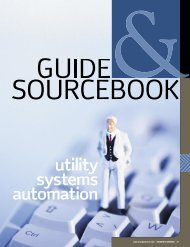We're growing our relationships - and we're making it ... - Description
We're growing our relationships - and we're making it ... - Description
We're growing our relationships - and we're making it ... - Description
Create successful ePaper yourself
Turn your PDF publications into a flip-book with our unique Google optimized e-Paper software.
California is way ahead of other states in emergency<br />
planning, says Ray Riordan, executive director<br />
of the California Util<strong>it</strong>y Emergency Association<br />
(CUEA), which evolved from the original 1952<br />
Office of Emergency Services. Located in Mather,<br />
Calif., CUEA, a voluntary group w<strong>it</strong>h 92 private<br />
<strong>and</strong> municipal util<strong>it</strong>y company members, basically<br />
acts as a clearinghouse for state util<strong>it</strong>y emergency<br />
preparedness <strong>and</strong> response — sponsoring workshops<br />
<strong>and</strong> programs, helping develop mutual aid<br />
programs, <strong>and</strong> keeping the issue very much on the<br />
radar screen of util<strong>it</strong>y executives.<br />
“We do a lot of lessons learned, best practices, <strong>and</strong><br />
how we can improve response,” Riordan explains.<br />
CUEA also helps ensure util<strong>it</strong>ies <strong>and</strong> other<br />
emergency responders work proactively w<strong>it</strong>h<br />
util<strong>it</strong>y companies. “We are a voice w<strong>it</strong>h the [state]<br />
Office of Emergency Services to exchange information<br />
<strong>and</strong> res<strong>our</strong>ces for mutual aid,” he says.<br />
The mutual aid can involve both in- <strong>and</strong> outof-state<br />
responses: CUEA coordinated California<br />
util<strong>it</strong>ies’ reaction in the aftermath of last year’s<br />
devastating Florida hurricanes.<br />
SEMS basically provides California w<strong>it</strong>h a<br />
coordinated response plan that ties together<br />
municipal <strong>and</strong> state organizations, including<br />
util<strong>it</strong>ies, when emergencies occur, <strong>and</strong> helps<br />
ensure they can communicate w<strong>it</strong>h each other<br />
<strong>and</strong> respond effectively. In some cases, m<strong>and</strong>ates<br />
specify that util<strong>it</strong>ies, for example, must be able to<br />
communicate w<strong>it</strong>h their customers w<strong>it</strong>hin a certain<br />
period about when power in affected areas will be<br />
restored. Essentially, <strong>it</strong> provides for a st<strong>and</strong>ardized<br />
response capabil<strong>it</strong>y that flows through the state’s<br />
emergency operations centers that are activated<br />
when a disaster occurs. Jim Bol<strong>and</strong>, director of<br />
safety <strong>and</strong> emergency services for SDG&E, says<br />
he’s noticed a dramatic change in the way util<strong>it</strong>ies<br />
in California <strong>and</strong> other states approach disaster<br />
planning over the last 15 years. Back in 1990, the<br />
typical response plan was operationally focused.<br />
Now, such plans are much more geared toward<br />
customer outreach. “We looked more internally at<br />
<strong>our</strong>selves in the past, he says. “Now <strong>it</strong>’s a more strategic<br />
approach” that includes, for example, letting<br />
customers know when power will be restored<br />
<strong>and</strong> establishing a system to check the status of<br />
employees own commun<strong>it</strong>ies after a disaster, so<br />
they can focus more easily on restoring services in<br />
badly impacted areas. California’s programs also<br />
have prompted util<strong>it</strong>ies to play a more proactive,<br />
planning role w<strong>it</strong>h other emergency agencies.<br />
Companies have become<br />
more sophisticated in disaster<br />
planning <strong>and</strong> response.<br />
Executives at other util<strong>it</strong>ies also believe that<br />
their companies have become more sophisticated<br />
in disaster planning <strong>and</strong> response. Pat Laird,<br />
vice president of corporate secur<strong>it</strong>y for Exelon,<br />
says util<strong>it</strong>y companies have adopted a two-tiered<br />
approach to emergency planning. The larger<br />
parent company focuses on business continu<strong>it</strong>y<br />
planning, <strong>making</strong> sure that the company <strong>it</strong>self<br />
can operate w<strong>it</strong>h key functions such as IT kept<br />
intact, perhaps from an alternate s<strong>it</strong>e, during an<br />
emergency. The individual util<strong>it</strong>y divisions, on<br />
the other h<strong>and</strong>, are more focused on field operations,<br />
restoring services as quickly as possible<br />
during emergencies.<br />
“We have a solid emergency plan in place, <strong>and</strong><br />
we conduct drills <strong>and</strong> tests,” Bol<strong>and</strong> says. “We feel<br />
confident that we’ll be able to respond effectively<br />
to a crisis.”<br />
EMERGENCY CHECKLIST:<br />
What Util<strong>it</strong>y Executives Need To Know<br />
Ray Riordan, executive director of the California<br />
Util<strong>it</strong>y Emergency Association has a long history of<br />
helping util<strong>it</strong>ies prepare for disasters. As the federal<br />
government becomes more involved w<strong>it</strong>h ensuring<br />
smooth communications <strong>and</strong> responses among<br />
various agencies, including util<strong>it</strong>y companies, he<br />
offers the following checklist for executives:<br />
1. Learn how to collaborate w<strong>it</strong>h other<br />
agencies. To be most effective, a util<strong>it</strong>y<br />
company must define a role among first<br />
responders to an emergency. At what<br />
point does the util<strong>it</strong>y become involved?<br />
2. Take prudent measure of what to implement.<br />
It’s important to know what kind<br />
of minimum response you’ll be expected<br />
to provide beforeh<strong>and</strong> <strong>and</strong> to ensure<br />
you’ll have adequate res<strong>our</strong>ces to do so.<br />
3. Support the emergency program once<br />
implemented. This includes providing<br />
the necessary training <strong>and</strong> emergency<br />
practices <strong>and</strong> <strong>making</strong> these visible <strong>and</strong><br />
familiar enough so they become part of<br />
y<strong>our</strong> routine daily operations. This lessens<br />
uncertainty during an emergency.<br />
4. Stress interoperabil<strong>it</strong>y. Make sure y<strong>our</strong><br />
systems can communicate efficiently<br />
w<strong>it</strong>h other first responders so that all<br />
agencies – fire, police <strong>and</strong> util<strong>it</strong>ies — will<br />
work together efficiently in an emergency.<br />
www.energycentral.com ENERGYBIZ MAGAZINE 33


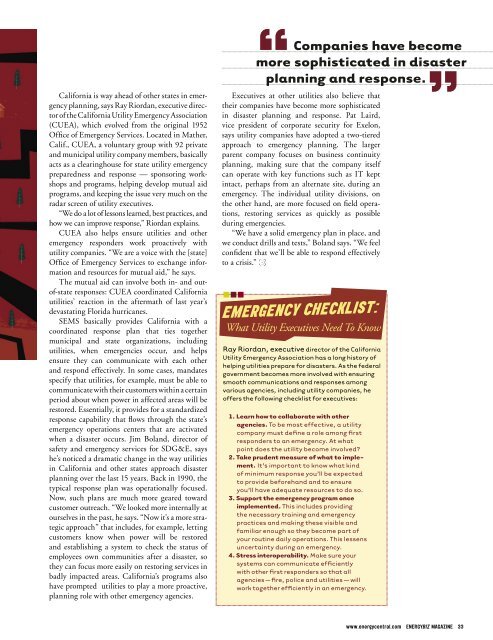

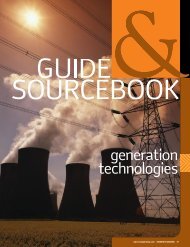
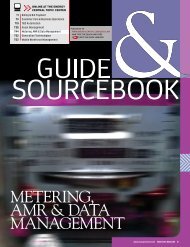

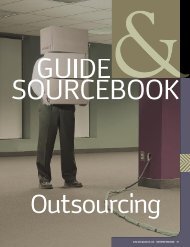







![View From the Trenches [PDF]](https://img.yumpu.com/18854438/1/190x252/view-from-the-trenches-pdf.jpg?quality=85)
